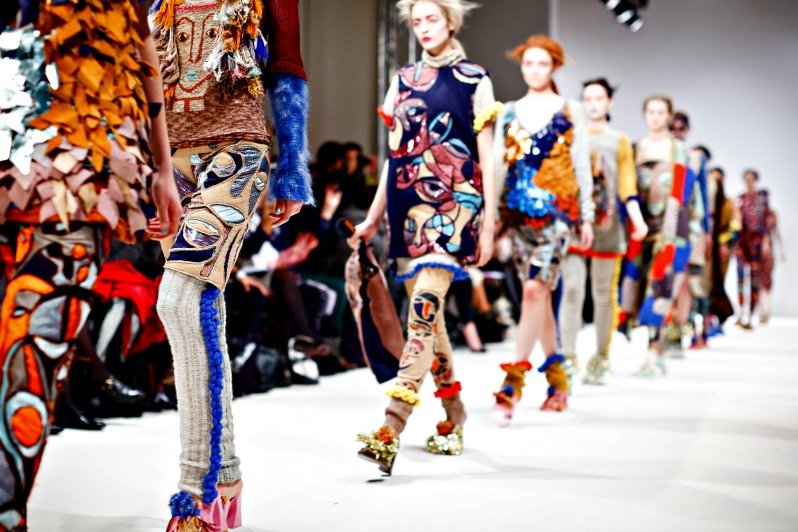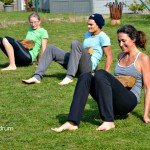For many of us, it’s that time of year when we start reorganizing our clothes closet, trading sweaters and scarves for light and breeze clothes and moonboots for flip-flops.
This moment seems to me like the perfect time to rethink the way we dress, not only from a minimalist point of view, but also from the sustainability approach. So let’s take it one step further, and ask ourselves about the usefulness of clothing.
Clothing has become much more than just functional garments covering up our bodies and protecting us from the elements. For many, it is part of their identity, of belonging to a group or a culture. The mere act of dressing is a form of self-expression and important nonverbal communication.
Have you ever asked yourself these questions?
Why do you dress?
How do you dress?
Why do you wear a certain garment?
Comfort? Fashion? Freedom of movement? Beauty? Inspiration? Protection?
I invite you to take a moment to stand in front of your closet and analyse what is inside of it.
A year and a half ago, I decided to do this exercise. My criteria for analysing the closet were:
Quantity
Quality (materials used)
Sustainability
Utility
Freedom
I will explain one by one.
Quantity
Sure, you know the feeling! You open the door of your stuffed closet, of which at least half of the stuff you haven’t worn for a very long time and you probably won’t ever again, putting on that sad face, and convincing yourself,
“I have nothing to wear!”
Although I’ve never had that many clothes, and I don’t consider myself a slave of fashion, this has happened to me too many times.
So one day, I decided to leave all this behind and do a thorough closet clean up, getting rid of all that:
- No longer inspired me and/or caused me any emotion.
- I hadn’t worn for years, but wasn’t willing to throw away “just in case.”
- Was made of unnatural materials, such as the famous 100% polyester.
I do admit that it took me quite a bit of effort to be able to change my way of thinking but I did it.
As proposed by Marie Kondo’s KonMari method, I took the time to touch every garment and feel the emotion that it caused me. It was a very useful way to decide whether to keep it or throw it away.
I still have a long way to go and many ways I can improve on this, but the main thing is to get started. Once the process is initiated, you will keep making progress along the way.
After this exercise, my wardrobe, my drawers, and my skin could breathe at last! In this sense, you may be interested in the challenge proposed by Valentina Thorner, the 333 proyect.
Quality
Say ‘no’ to plastic and petroleum-based clothing (polyester, nylon, acrylic, etc.) and yes to natural fibers (organic cotton, hemp, linen, wool, etc.).
By analyzing the inventory of my clothes by the method described above, I realized that most of the items belonged to the first group or carried mixed materials from both groups. I learned later that mixed materials cannot decompose or biodegrade.
The skin is the largest organ of our body; it’s our means of communication with the outside. Why wouldn’t we want to give it the best, just as we do with the food we eat? Why do we mistreat our skin, using harmful unnatural fibers?
Sometimes we prefer not to know. As long as it’s cheap and fashionable, it seems ok. I admit that it took me quite a lot of time to be aware, but even more time to actually act on that knowledge.
In other blog posts I have spoken about everything being energy, and that we all are energy. The clothes we wear also transmit a corresponding vibration. Surround yourself with beautiful things, handmade with natural materials! Creativity and love make you feel a thousand times better than having plenty of soulless things, mass-produced by human beings in conditions of intolerable exploitation.
My advice? Possess little, but make sure it’s high in beauty and talent – things that make you feel great.
Sustainability
The sustainability of a garment is directly related to the conditions in which it was manufactured.
As well explained by Laura Martinez Hortal, owner of the magazine Wild Geese, sustainable fashion is one that meets the following requirements:
- Human rights are respected in manufacturing.
- No minors are hired.
- Only non-toxic environmentally friendly materials are used.
- The fabrics are recyclable and durable.
- The environment is respected in the cultivation of its raw materials.
- The packaging and transport are of minimal impact on the environment.
- Animals are not mistreated.
- Trade with the producer and the supplier is fair.
- Waste is reduced and recycled.
That’s a challenge, right? If you haven’t seen it yet, take a look at this and this.
After reading this, who wouldn’t feel bad? But what can be done about it?
The first step is not to fall into a guilt trap, which solves nothing. Work on your awareness and progress slowly, as the famous Japanese kaizen “Continuous Improvement” philosophy teaches us.
The second step is to dismantle the two main arguments against sustainable fashion:
1. It is too expensive. Look again point number one. Can you imagine having a closet with only a few clothes, but all of it sustainable and of high quality , filling you with wellness and joy when wearing them?
One of the universal laws is “You Get What You Give.” If you are not willing to pay someone for the value of their work and time, you cannot expect that you yourself will be paid what your work is worth. Doesn’t it strike you that the emergence of low cost goods in our modern economy is accompanied by a vertiginous drop in wages? It makes me think … how about you?
2. It is not pretty. Pretty for who? Beauty is subjective; it is not based on a set of rules. Why don’t you dare to have your own style and ethics not dictated by the fashion industry?
Break free from the dictates of trends, and wear what pleases you or what you makes you feel good! Fortunately, the availability of sustainable garments is growing, and it’s becoming more common to find beautiful pieces online or in alternative clothing stores. .
When shopping, avoid what I like to call the “Globalization Street,” and get lost in the small streets downtown, discovering charming little shops where art, creativity, and talent are all over the place, rather than mass production.
On top of that, when you buy from local shops, the money stays in the community.
Utility
I find it disturbing and overwhelming to look around me and find lots of useless things. It takes away my energy! The same happens to me with clothes. I have become very selective when buying.
This is my check list. I pick up the object, look at it, and think:
Will it make me really happy or is it just going to be another piece of clothing?
How many times will I wear it?
Do I really like it a lot?
How will I feel when I put it on?
Where will it end up when I’m tired of it?
I assure you that my decision is made in seconds. It requires a little practice, but is very liberating.
Freedom
The initial purpose of clothing was to protect us from the elements. Animal skins were functional in winter and in summer; you could freely enjoy the sunshine without the unsightly marks of a bathing suit.
Until one day, someone decided that nudity was indecent, and it became one of the biggest taboos in the history of mankind.
So we had to get dressed.
And with clothes fashion came the division of social groups and classes, but also the fashion addiction.
In addition to that, clothing can seriously limit freedom of movement.
Sometimes I think of clothes that I wore over my life and I cannot avoid a smile of compassion for myself: impossible heels, tight pants, tight skirts, stockings, bras, etc. Today, all those corsets and torture devices that someone decided would enhanced a woman’s figure are gone. What a relief!
Regarding men, they are not that far behind us, though fashion has always been less ruthless towards them. Think, for example of ties and belts. Check this out.
Okay, this sounds great right? But reflect for a moment.
Would you want to see your children sewing clothes in miserable conditions?
Some of us continue to look away and end up falling into the spiral.
Why?
Buying clothes has become an addiction, filling up our empty spaces of authentic values. Not that those values have been lost, but we have forgotten them. We have converted leisure time in consumerism. Leisure is no longer understood without spending money. You have to go shopping, be trendy, go to the cinema or theatre, have dinner in trendy restaurants, or go for a city trip – consume and consume! Escape the emptiness that our consumer society itself has created!
But what really fills those empty corners is free: friendship, love, kisses, caresses, laughter, and nature.
So, my proposal for today:
1. Open your closet, reflect on your choices, and liberate yourself from all the excessive, useless stuff.
2. Next time you buy something, think twice. Feel the emotion it provides you, and if you decide to buy it, make sure is as sustainable and natural as possible.
3. Now fill your empty spaces and drawers with values that are important to you instead of useless clothes and things.
And now, tell me! What’s in your closet?
A hug!








Recent comments